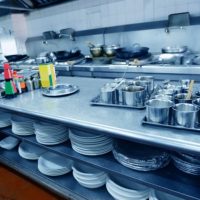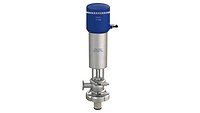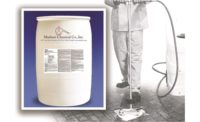Chemical-Free Cleaning: Revisited

Two things happened in 2010 that impacted the way we approach sanitation. First, a book entitled Extreme Green Cleaning by Vince Elliott was published and made available to the janitorial industry. In it, the author detailed a performance-based strategy for cleaning commercial buildings without chemicals. The book catalogued all chemical-free cleaning technologies and detailed use, advantages and disadvantages of each in an unbiased presentation. Secondly, a conference was held in Fort Lauderdale, FL, on extreme green cleaning concurrent with the book’s release. For the first time, manufacturers and users of new chemical-free technologies that did not require compliance with Federal Insecticide, Fungicide, and Rodenticide Act regulations enjoyed an exclusive audience of like-minded stakeholders in the janitorial/sanitation industry. New approaches to cleaning and sanitizing were introduced, demonstrated and discussed. Comparisons were made, experiences were exchanged without economic competition, and the pros and cons of the various technologies available were aired among the participants. The significance of both the book and the conference was that they closely followed the introduction of the U.S. Environmental Protection Agency (EPA)’s “Tools for Schools” initiative, a formidable uptick of the Leadership in Energy and Environmental Design program and the realization that the 2005 Food Code allowed for the on-site generation of sanitizers. Among the attendees from the food industry, we sought out these new technologies as a toxin-free alternative to the chemicals and more traditional approaches to sanitation in common use.
We soon realized that some of these new ideas were limited in their use in food production and food retail. We could not easily validate their efficacy, regardless of the claims made. We also found that some uses were limited because of the units’ design, capacity and application, and that some of these chemical-free approaches were not entirely cost-efficient or cost-effective. To make matters worse, federal regulators eschewed anything that did not have an EPA registration number, even when shown that it was specifically exempted in 21 C.F.R. and allowed in the 2005 Food Code. As a result of these negative influences on a fledgling technology, the industry rallied and targeted the problems in a cogent and deliberate approach by developing workable solutions and exploring new ways to legitimize their products when used in accordance with manufacturers’ recommendations.
In four short years, the chemical-free cleaning industry made a quantum leap to legitimize its newly, and sometimes redesigned, technologies for application in nontraditional use within the food industry. It did this by listening to potential customers, applying good science, employing third-party validation, avoiding spurious and exaggerated claims and, most of all, by excellent engineering. While numerous new technologies are indeed “green” and quite worthy of consideration, there are three that have undergone the most significant transformation in the broadest sense and show the greatest promise for chemical-free cleaning in the food industry. These are electrochemically activated water, dry steam and dry ice blasting.
The most significant drawback to acceptance of electrochemically activated water, particularly the single- or mixed-stream technology, as well as dry steam application, was the validation of microbicidal claims. In either case, the challenges outlined by EPA acceptance criteria for disinfectant and sanitizer testing, namely, the Use Dilution Test and the Official Detergent Sanitizer Test, could not be applied for several reasons. The most significant were the lack of uniformity in concentration of the biocidal moiety, temperature fluctuations, the lack of any residual properties and stability in storage. Even if these criteria could be met, the question remained about the construction of the sanitizing units and the potential for leaching toxic materials such as heavy metals during their use and operation. In both cases, NSF International developed formal protocols (equivalent to standards, but designed for a unique product or system).
Protocol Validation
NSF Protocol P415, Electrochemically Activated Water Cleaning and Sanitizing Devices in Commercial Food Operations, incorporated repeatable biocidal challenges modified from the official testing methodology without compromising rigorous challenges or interpretation. It also provided mandatory verification of requirements stipulated in normative reference standards for toxicity, labeling and materials of construction, and included uniform definitions and user safety (UL). It even included the Codex standard for food-grade salt.
NSF Protocol P448, Sanitization Performance of Commercial Steam Generators, addressed the concerns regarding the dry steam delivery units. The NSF team developed a specific testing method to measure biocidal activity when the dry steam is applied to an environmental surface. In so doing, the team needed to separate cleaning from sanitizing and conducted numerous tests on various materials, using differing times, applications, temperature variations and requirements for performance until a uniform, repeatable and rigorous challenge was met. The protocol echoes most of the requirements of P415 by incorporating normative reference standards, going even one step further by addressing descaling capabilities of the boiler.
Both protocols were reviewed by a panel of experts from academia, industry and government, and released for public comment prior to being vetted by the NSF Council of Public Health Consultants, which included members from local, state and federal governments, including the U.S. Food and Drug Administration and EPA. In the absence of any microbiocidal claims, no protocol is being considered for dry ice blasting at this time.
In addition to NSF listing, many newly developed chemical-free cleaning technologies are being reviewed and challenged by the Toxic Use Reduction Institute (TURI), a nonprofit organization based at the University of Massachusetts, Lowell. The TURI Cleaning Laboratory uses standardized testing procedures to test both industrial cleaning and janitorial cleaning products and offers performance validation testing for label certifications such as Green Seal or government purchasing programs.
In short, third-party validation of chemical-free cleaning products and systems is ongoing and no longer left entirely to the wiles of sales and marketing. Performance and safety data are available for comparisons, and with increased use, unbiased testimonials by users will help put these technologies squarely in the food operation marketplace.
Product and System Use
The uniqueness of electrochemically activated water, dry steam and dry ice blasting used in commercial food operations is that they complement one another. No single technology can do it all, but collectively they are capable of doing everything conventional wet-chemical cleaning systems can, without toxins, adverse health effects, damage to the environment or compromises to worker safety. They are truly “green” by definition, easy to use, effective and, in the long run, quite economical.
On a cautionary note, the use of these newly emerging technologies may require different ways of cleaning, such as the assistance of microfiber and nonabrasive attachments and tools, along with altering cleaning schedules and training strategies—all to the positive. The following provides a brief and basic review of the three technologies. To learn more, you will find a wealth of information posted on the Internet and through the dealer networks of these sanitizing units.
Electrochemically Activated Water
Electrochemically activated water, also known as electrolyzed water, ionized water, antioxidant water and engineered water, has been successfully used throughout the food industry for well over a half century. It consists of a device that uses potable water in which salt is dissolved that is subjected to some form of electric current, and in some cases uses ion-selective membranes in electronic cells to produce the activated water. The result is the formation of two types of solutions. The first consists of a catholyte that contains a high-pH, noncorrosive dirt- and grease-cutting cleaner: sodium hydroxide (lye). The catholyte is basically an amphoteric detergent that completely dissociates into the two ions Na+ and OH–, which are capable of converting oils and greases into water-soluble soaps. Because the catholyte has both charges, it can also react with most molecules and polymers by breaking them up and reducing surface tension—the basis of cleaning. The second solution consists of an analyte, which is a low-pH, high-dissolving, oxygen- and chloride-containing sanitizer: mostly hypochlorous acid. This is an effective and safe sanitizer that can also serve as a disinfectant at high concentrations (>200 ppm). Up to 200 ppm, hypochlorous acid is exempt from EPA listing.
Electrolyzed water comes in two forms; the more common is a split-stream continuous process that produces the analyte and catholyte in separate streams ready to use in any comprehensive sanitation program. The lesser known of the two forms is the single- or mixed-stream batch process that contains both solutions in a noncorrosive balance. While the former is better suited to general sanitation in larger commercial food operations, the latter is ideal for spot cleaning, particularly in retail food environments. The advantages of either system include safety, nontoxicity and cleanability. Each system has limitations, but these are outweighed by comparing the activated water systems’ performance with conventional cleaning methods. There is a wealth of information available through numerous publications. A simple Google search will provide a good starting point for choosing the ideal system for any food operation.
Dry Steam
Steam cleaning came into its own in the 1920s. It was primarily used for removing grease from heavy machinery in a steam/hot water mixture. Other than the wet house-steam and in-place steam-cleaning systems, the newer, small, portable, hotter and dryer batch steam units along with specialty tools are only about two decades old. Until the smaller units appeared on the market, federal regulators were concerned about the volatile amines used in house steam and their potential contamination of food contact surfaces, which has traditionally limited the use of steam in food operations. Although these smaller, versatile units have made significant inroads into the retail food industry, acceptance has not kept up with their utility due to this historical concern. To assuage this caution, the newer and smaller units use potable water, thereby eliminating any toxic moieties carried by the steam during the cleaning process. The new portable units are well engineered, and the electronic controls provide additional safety and operational advantages, particularly if boiler temperature drops much below 290 °F. The units that are listed in the NSF protocols have an additional assurance that all water and steam contact surfaces are corrosion resistant, that no toxin is released during operation and that they have a demonstrated ability to clean and sanitize food contact surfaces.
The portable dry steam units have several basic advantages when used in conjunction with a comprehensive sanitation program. While these units do not replace traditional wet cleaning throughout a food operation, their ability to rapidly remove soil and provide a sanitized surface has made them ideal for use on deli slicers, choppers, mixers and meat processing equipment, just to name a few examples, during the production day, without major interruption or extensive cleanup that accompanies the more traditional wet cleaning of these types of equipment. The dry steam units have also found utility in processing plants for the spot-cleaning of clean-in-place equipment where splash could possibly contaminate the surrounding critical food zone areas. In fact, several models now incorporate a HEPA-filtered wet/dry vacuum units to capture moisture from condensation and soiling loosened from the surfaces. The high-efficiency filters of the vacuum exhaust prevent redistribution of the soil and soil-laden moisture. A second advantage is their safety, portability and utility. The units themselves are small enough to go anywhere within a facility, and the accompanying available accessories are tailored to meet most cleaning tasks, particularly the removal of baked and caked-on food residue. Users of the portable dry steam units find them versatile, safe and easy to operate with minimal instructions. They are designed for operator safety and ease of use. They are also quite robust and require little maintenance; downtime is minimal and, if properly serviced, they will provide continuous and long-lived utility. Finally, dry steam is an efficient, nontoxic cleaning system that leaves no chemical residue and is a welcomed addition to a green cleaning and sanitizing program.
Dry Ice Blasting
Dry ice blasting is ideal for use in directed cleaning of areas where wet cleaning may be problematic such as in bakeries to remove carbon from racks and pans, as well as refrigeration equipment, ovens and stubborn, caked-on food splash from walls, floors and appurtenances. Dry ice blasting is a process in which solid carbon dioxide is accelerated in a pressurized dry air stream. The portable dry ice blasting equipment uses solid CO2 pellets that can be easily manufactured on site or supplied by a vendor; both are produced from recycled gas. The pellets themselves are nonconductive, chemically inert, nontoxic and nonflammable, and the process leaves no residue. They can clean almost any surface without damage because they are nonabrasive. The cleaning process has two phases; the first is through kinetic energy when the pellets impact upon a soiled surface. The second is when the dry ice further loosens any soiling through sublimation. Sublimation is where the CO2 changes instantly from a solid to a gas with a 400-fold increase in volume, thereby creating mini-explosions upon impact.
Initially, this technology had its drawbacks: the delivery nozzle would freeze over and the application wand would become encrusted with ice. However, the newer models have corrected this by providing dried air as a pressurized accelerant, and redesigning and effectively insulating cold-exposed parts to prevent ice buildup.
Bottom Line
Chemical-free cleaning in the greater context of green cleaning is becoming the rule instead of the exception. The demand for nontoxic and residue-free cleaning systems parallels the customer demand for genetically modified organism-free and organic foods. The chemical-free systems described have become integral to many commercial food operations, with considerable success and enthusiasm. The engineering is much improved, and the methodologies briefly described above, as well as other types of chemical-free cleaning and sanitizing systems, are quite cost-competitive when considering their use, labor savings and amortization. Information is readily available on all systems, and most importantly, third-party providers are willing to effectively and economically substantiate manufacturer’s claims, and craft protocols and standards to ensure public health and safety.
Forensic sanitarian Robert W. Powitz, Ph.D., M.P.H., R.S., C.F.S.P., is principal consultant and technical director of Old Saybrook, CT–based R.W. Powitz & Associates, a professional corporation of forensic sanitarians who specialize in environmental and public health litigation support services to law firms, insurance companies, governmental agencies and industry. For more than 12 years, he was the director of environmental health and safety for Wayne State University in Detroit, where he continues to hold the academic rank of adjunct professor in the College of Engineering. He also served as director of biological safety and environment for the U.S. Department of Agriculture at the Plum Island Animal Disease Center at Orient Point, NY. Among his honors, Powitz has received the NSF/NEHA Walter F. Snyder Award for achievement in attaining environmental quality and the AAS Davis Calvin Wagner Award for excellence as a sanitarian and for advancing public health practice. He is the first to hold the title of Diplomate Laureate in the American Academy of Sanitarians and is a diplomate in the American Academy of Certified Consultants and Experts and with the American Board of Forensic Engineering and Technology. He is a member of the editorial advisory board of Food Safety Magazine and can be reached at Powitz@sanitarian.com or through his website at www.sanitarian.com.
Looking for a reprint of this article?
From high-res PDFs to custom plaques, order your copy today!








